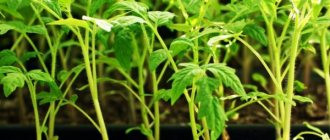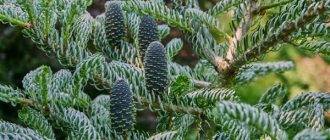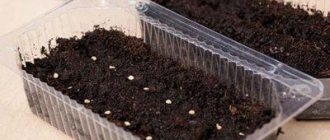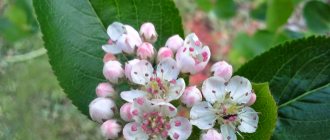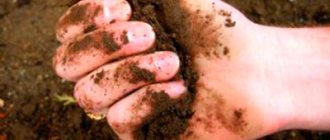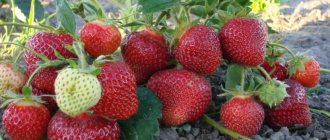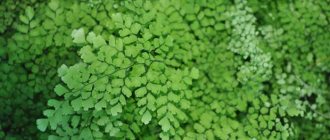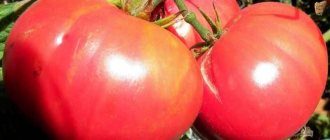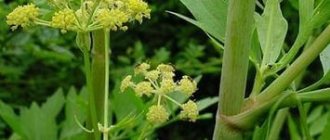Hyssop is a unique plant, known since biblical times (the name of the miracle herb was given by the ancient Jews, who called it “sacred grass” - “esob”) as a healing plant that can cope with many ailments.
Nowadays, this unpretentious culture is of interest not only to herbal healers, but also to beekeepers, perfumers, cooks, winemakers, and landscape designers.
A winter-hardy perennial that can withstand prolonged drought, does not make any demands, and is able to survive without any care.
But if you pay due attention to this plant, it will surprise you with incredibly abundant and long-lasting flowering, worthy of the attention of designers.
Popular types and varieties with photographs
Only 3 species of hyssop are known in the wild, but breeders have bred other varieties with decorative properties. The most popular types of hyssop among gardeners are:
- Drug. In nature it grows on mountain slopes and steppe zones. The height of the shoots is about 50 centimeters. Flowers are blue or purple. It is a valuable honey plant. Used as a seasoning in cooking and for preparing medicinal tinctures.
- Doubtful. Plant height is 25-30 centimeters. The flowers are blue-purple. Prefers rocky soils.
- Aniseed . A low species used as borders for garden paths and framing ridges. Has a grown anise aroma. Common varieties: pink flamingo, Amethyst, Doctor, etc.
- Narrow-leaved. Height 30-35 centimeters. The flowers are violet-blue. In canning it is used as a flavoring agent. It is used as a spice for cooking fish.
- Cretaceous . It got its name due to its initial growth on chalk formations. Blooms blue flowers with a balsamic scent. Used as a fragrance in perfumery. This species is rare and is therefore listed in the Red Book.
- Zeravshansky . The tallest species is up to 80 centimeters. Blooms white.
Hyssop
Growing and care in open ground
Hyssop is an unpretentious plant and therefore planting and caring for it in open ground requires minimal effort. But compliance with certain conditions to maintain decorative plantings is still necessary.
Choosing a landing site
The ideal area for hyssop is an open or slightly shaded space. Planting it in the shade and in waterlogged areas is not permissible. It is especially not recommended to plant hyssop near ponds and under trees: in such conditions it will feel oppressed, although it will not die.
Hyssop can be grown in one place for 5 to 10 years, then replanting is necessary. If you do not change the place of cultivation, the plant will begin to degenerate: the shoots will begin to become smaller, the number of flowers will decrease.
Hyssop doesn't like shade
Soil composition requirements
Any garden soil is suitable for growing hyssop, since it is not particularly demanding on the quality of the soil. The only contraindication is areas with high acidity. Therefore, the area for growing hyssop must be limed.
[adsp-pro-5]
The site has been dug up since the fall. Fill with compost (5 kilograms per square), superphosphate (30 grams), potassium salt (20-30 grams). In the spring, the soil is dug up again and 15-20 grams of ammonium nitrate or urea are added to it. With such soil preparation, hyssop will feel good and bloom profusely for 5-6 years.
Properties of hyssop - harm and benefit
Medicinal properties of hyssop
The beneficial properties of hyssop have been used by mankind for a long time. The plant contains a large amount of vitamins: A, B, C, E, K, D and PP. The leaves and roots of hyssop are rich in iron, copper, manganese, potassium, selenium, chlorine, silicon, fluorine, tungsten and boron. Hyssop also contains tannins, bitterness, aldehydes, oleanolic and ursolic acids, flavonoids, alcohols and essential oils. Varieties with white flowers contain the maximum amount of essential oil, and varieties with pink flowers contain the minimum.
Hyssop has an expectorant, antipyretic, antiseptic, diuretic, bactericidal, laxative, analgesic, antimicrobial, anthelmintic, wound-healing and stimulating effect. Hyssop is used for infectious and colds, diseases of the oral cavity and respiratory tract, inflammation of the urinary tract, rheumatism, neuroses, angina pectoris, colitis, bloating, conjunctivitis and skin diseases.
For healing purposes, not only leaves and roots are used, but also hyssop flowers, which are dried and added to tea for various diseases, but most often hyssop preparations such as decoction, tincture or infusion are used. The tincture is used for gastrointestinal diseases, for the treatment of hematomas, wounds, burns and other skin injuries. Hyssop infusions are used to gargle for stomatitis and wash the eyes for conjunctivitis. Decoctions are used to treat the upper respiratory tract, colds and inflammation of the urinary tract. Tea with hyssop is useful for coughs, colds and sore throats; it increases blood pressure, lowers temperature and calms the nerves.
Hyssop - contraindications
Since hyssop is a slightly poisonous plant, it should be used for medicinal purposes and as food with caution. This contraindication of hyssop makes it necessary to consult a doctor before taking it, since in large doses and with prolonged use, hyssop can cause spasms. It is not recommended to use hyssop for pregnant women, children under 12 years of age, people suffering from kidney disease, hypertension or high stomach acidity. Hyssop is also contraindicated for nursing mothers, since hyssop contains components that can reduce and even completely stop lactation.
Seedling and non-seedling growing methods
Hyssop can be easily grown from seeds, using sowing in open ground or through seedlings.
Sowing seeds in open ground
Growing from seeds is possible when sowing before winter, since they will undergo a process of natural stratification.
Hyssop can be grown by seed
Possible sowing in spring. Before sowing, the seeds are mixed with coarse sand, poured into prepared furrows and sprinkled with a 1-centimeter layer of soil. To prevent the seeds from being washed away when watering, the furrows are additionally mulched with peat. This technique will also help prevent the formation of a crust on the surface of the grooves. When sowing in autumn, mulching with peat is not used.
Important. The seeds are quite small, so it is not recommended to sprinkle them with a large layer of soil.
Hyssop germinates at a temperature of plus 2-3 degrees in 10-14 days. When sowing seeds, flowering occurs 2 weeks later than with seedlings. Flowering with this method of cultivation begins only in the second year.
Growing seedlings
When hyssop is grown through seedlings, the plant begins to bloom in the first year after planting. Sowing of seedlings is carried out in early March. The seeds are sown in a shallow container and sprinkled with a 1-1.5 centimeter layer of soil. The crops are covered with glass or film.
Hyssop seedlings need picking
At the stage of two true leaves, the seedlings dive into separate pots. So that when transplanting into open ground the roots are not damaged. When picking, the sprouts are buried 7-8 centimeters so that the growth point is on the surface.
Hyssop plant - description
The root of hyssop is woody, the stems are branched, tetrahedral, short-haired or almost bare, twig-like, woody at the base, 45 to 70 cm long. The leaves are almost sessile, opposite, short-petiolate, lanceolate, entire, 2 to 4 cm long and 4 cm wide. up to 9 mm. Small two-lipped purple, blue, white or pink flowers, located 3-7 pieces in the leaf axils, form an apical spike-shaped inflorescence. Hyssop continues to bloom from June to October. The aroma of the plant attracts bees to the garden: any type of hyssop is a honey plant. Hyssop seeds, which ripen in the second half of August, remain viable for three to four years. Possessing a strong spicy aroma, the plant remains green even with the onset of winter.
Hyssop is a popular culinary spice and a universal medicine.
- Pepper: growing from seeds in the garden
Open ground planting technology
Hyssop seedlings are ready for planting in open ground at the age of 50-60 days. By this time, 5-6 true leaves are formed on each plant. Planting is carried out when the outside temperature is stable and not lower than 10 degrees Celsius. Adult plants are not afraid of short-term frosts, but young, not yet rooted bushes may die. If there is a threat of night frosts, young plants are covered by installing a wire frame over them .
Important. The distance between hyssop bushes is 30-40 centimeters. With this planting pattern, they form a dense living border.
Features of caring for hyssop
Hyssop needs regular watering, loosening the soil and fertilizing. Watering should be frequent but moderate. The soil is slightly moistened so that the roots do not become soaked and begin to rot.
Hyssop prefers moderate watering
In the first two years after planting, special attention should be paid to regular feeding. Organic and mineral compounds are suitable for fertilizer. Feeding is carried out once every 20-30 days. With the beginning of flowering, nitrogen is completely removed from the fertilizer. For adult bushes, fertilizers are not so important, since they perfectly extract minerals from the soil on their own.
Advice. To prolong the flowering of hyssop, it is necessary to regularly pick off wilted buds from the bush.
After flowering, the plant must be prepared for wintering. At the end of autumn, sanitary pruning of shoots is carried out, which stimulates the growth of new stems in the next growing season. After pruning, shoots 10-12 centimeters high should remain.
[adsp-pro-6]
Hyssop does not need shelter for the winter. To protect against drying frosts, you can lightly sprinkle the rhizome with leaves or small straw.
How to grow hyssop
Hyssop care
Growing hyssop is a simple and enjoyable task. All you need to do is water it occasionally, loosen the soil around the bushes, remove weeds at first and add fertilizer to the soil. Hyssop is watered only during prolonged drought, spending 15-20 liters of water per m² of plot, but usually the plant looks fresh even in severe dry conditions, and natural precipitation is sufficient for it.
If it seems to you that hyssop is growing slowly, feed it with a solution of complex mineral fertilizer at the rate of 20-30 g per 10 liters of water, although it is better to use organic fertilizers. If the plant does not bloom well, this means that the soil is oversaturated with fertilizers, and hyssop does not like this.
- Astrantia: growing from seeds, types and varieties
Formative pruning of hyssop is usually combined with the preparation of medicinal raw materials. The plant tolerates cutting easily and grows back quickly after it. The plant overwinters without shelter. In autumn, hyssop shoots are cut at a height of 10-15 cm. This is done in order to stimulate abundant flowering and the formation of a dense bush in the next growing season.
If you grow hyssop as a medicinal raw material, try to avoid self-sowing, as this weakens the healing properties of the plant. To avoid self-seeding, you need to carry out regular weeding and cut the bush before the seeds begin to ripen.
Although hyssop can live in one place for a decade, after 4 years it begins to bloom worse, so you should rejuvenate the plant by cuttings or dig up, divide and transplant the hyssop bushes to a new place.
Pests and diseases of hyssop
Hyssop is extremely disease and pest resistant, but can sometimes be affected by rust, rhizoctonia, fusarium wilt or white spot. You can destroy pathogens by treating hyssop with fungicides, but if you follow crop rotation and plant care rules, hyssop is unlikely to get sick. Do not forget to remove plant debris from the area after autumn pruning.
As for pests, the smell of hyssop repels them not only from the area with the plant, but also from crops growing in the vicinity of the hyssop.
What to plant after hyssop
After hyssop, you can plant beans, peas, potatoes, tomatoes, onions and garlic.
Plant propagation methods
It is necessary to replant or renew hyssop bushes every 5-7 years so that it does not degenerate and maintains maximum decorativeness. Three methods are acceptable for propagation: sowing seeds, dividing the bush and cuttings. The seed propagation method was described above.
The bush needs to be renewed every 5-7 years of its life.
Dividing the bush
The fastest way to get a large number of bushes in a short time. The bush is dug up in the fall, after flowering, and divided into several parts. The resulting specimens are planted in separate holes and watered abundantly. After planting, watering is not carried out. The division must be carried out before the onset of frost so that the resulting plots have time to take root.
Propagation by cuttings
This method is suitable for propagating hyssop throughout the growing season. Cuttings 10 centimeters long are cut from the bush and rooted in a mixture of sand and peat, buried halfway. To retain moisture in the substrate, the cuttings are covered with glass or plastic caps. Plantings need to be protected from sunlight and watered periodically.
As soon as the cuttings sprout, the caps are removed from them. The resulting plants can be planted in a permanent place in the fall. Hyssop obtained from cuttings blooms the next year.
The plant can be propagated using cuttings
Important. When growing hyssop, it is necessary to periodically prevent its reproduction by self-sowing. Bushes from seeds spilled onto the soil grow weakly, the area quickly becomes clogged and takes on an unkempt appearance.
How to collect hyssop seeds
Seeds are harvested at the time when the boxes begin to turn brown. You should not wait for the seeds to fully ripen so that the box does not open and the seeds spill onto the soil. The seed pods are cut off along with the shoots and hung upside down in a dry place. To prevent the seeds from spilling out after ripening, the branches are placed in fabric bags.
Before spring planting in open ground, the seeds are stratified in the cold for 30 days. When sowing seedlings, stratification is not necessary.
Beneficial features
Hyssop flowers, leaves and stems contain many beneficial substances. Among them are:
- vitamins;
- essential oils;
- flavonoids;
- glycosides;
- bitterness;
- tannins;
- resin.
For medicinal purposes, the entire above-ground part of the plant is harvested. The collection is carried out in the summer at the budding stage. The raw materials are dried in the open air under a canopy. Over time it becomes less odorous. The plant is crushed and placed in a paper or fabric bag. The medicine should be stored in a cool, ventilated place.
Folk remedies from hyssop in the form of decoctions, alcohol tinctures, ointments, oils and lotions are used in a wide variety of cases. They have expectorant, laxative, bactericidal, diuretic, and stimulant effects.
Tea helps strengthen the immune system and alleviate colds, bronchitis, runny nose, and asthma. Lotions relieve pain and inflammation resulting from injuries and bruises, they are also used to treat fungal infections. Decoctions are taken orally for gastrointestinal upset. They also have a beneficial effect on women’s health (they relieve pain and mood swings).
Hyssop has stimulating and tonic effects. However, this is its contraindication for pregnant women and people suffering from seizures and epilepsy. Under no circumstances should they not only take the product internally, but even inhale the aroma of essential oil.
Use in landscape design and combination with other plants
This shrub remains decorative throughout the growing season, so its use of hyssop in landscape design is quite diverse. It will serve as an excellent decoration for rockeries and alpine slides; hyssop looks especially impressive against the background of stones. Combinations with mint, lavender, rosemary, oregano and sage create a real medicinal flower bed.
Hyssop is used as a frame for garden paths. To do this, low varieties are planted at a distance of 25-30 centimeters from each other. An interesting solution is to fence certain areas of the lawn with hyssop bushes and plant tall perennials inside the same hedge.
You can get acquainted with the features of growing and caring for hyssop in the video material. Enjoy watching!
Use in folk medicine
Best materials of the month
- Coronaviruses: SARS-CoV-2 (COVID-19)
- Antibiotics for the prevention and treatment of COVID-19: how effective are they?
- The most common "office" diseases
- Does vodka kill coronavirus?
- How to stay alive on our roads?
In folk medicine, this medicinal herb is most often used in the form of teas, decoctions, infusions and alcohol tinctures.
Hyssop tinctures are often used for external diseases to treat wounds, hematomas and burns, as well as for diseases of the gastrointestinal tract. They are especially good for bloating or intestinal colic.
Decoctions are often used in the treatment of diseases of the respiratory and urinary systems, as well as colds.
Teas also help cope with colds and are useful during sore throats and prolonged coughs. They also effectively relieve fever, improve the functioning of the stomach and intestines, relax and soothe.
Hyssop infusions are used to rinse the mouth and throat for various inflammations or stomatitis, and for conjunctivitis it is effective for washing the eyes. Often such infusions are used to improve appetite.
Hyssop decoction
To prepare, you need to pour one liter of boiling water into one hundred grams of dried hyssop herb and boil for five minutes. Afterwards, strain the broth and add 150 grams of sugar. Use three to four times a day. The maximum daily dose is no more than 100 ml of the product.
Hyssop tincture
Add one hundred grams of dry hyssop to a liter of dry white wine and leave for three weeks in a dry, dark and cool place. The tincture must be shaken every day during this entire time. After this, strain the medicine and take a teaspoon three times a day.
Hyssop infusion
Pour twenty grams of dry grass into a thermos and pour a liter of boiling water. It will take thirty minutes to fully cook. After this time, it must be strained and taken three times a day, half a glass.
